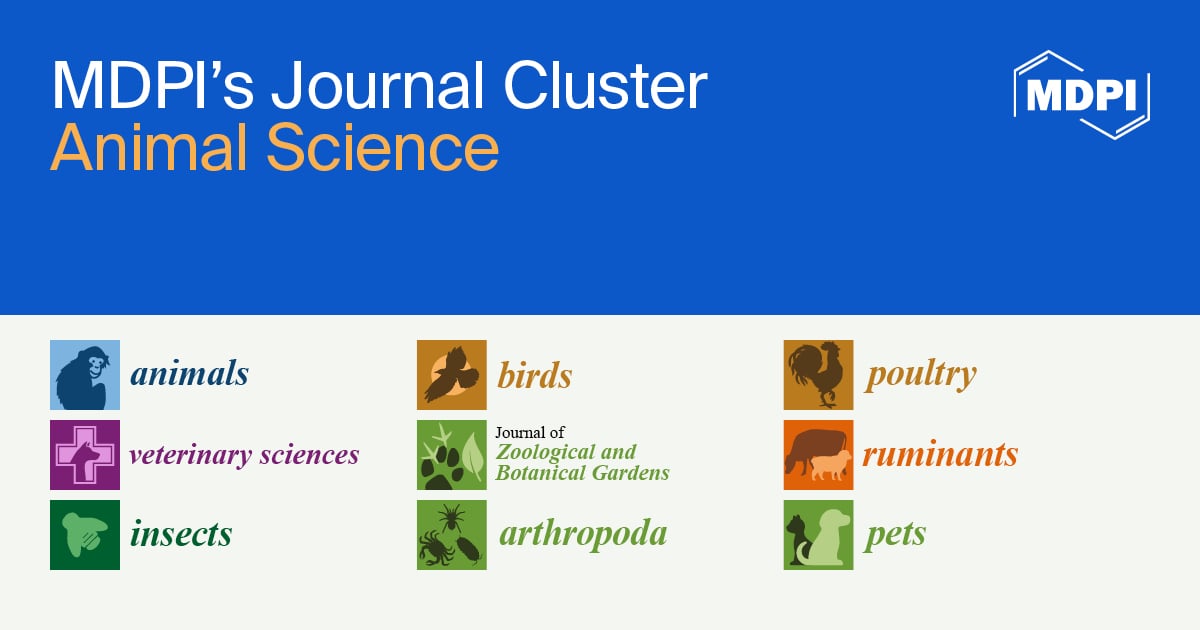Journal Description
Animals
Animals
is an international, peer-reviewed, open access journal devoted entirely to animals, including zoology and veterinary sciences, published semimonthly online by MDPI. The World Association of Zoos and Aquariums (WAZA), European College of Animal Welfare and Behavioural Medicine (ECAWBM), and Federation of European Laboratory Animal Science Associations (FELASA) are affiliated with Animals and their members receive a discount on the article processing charges.
- Open Access— free for readers, with article processing charges (APC) paid by authors or their institutions.
- High Visibility: indexed within Scopus, SCIE (Web of Science), PubMed, PMC, Embase, PubAg, AGRIS, Animal Science Database, CAB Abstracts, and other databases.
- Journal Rank: JCR - Q1 (Veterinary Sciences) / CiteScore - Q1 (General Veterinary )
- Rapid Publication: manuscripts are peer-reviewed and a first decision is provided to authors approximately 16.1 days after submission; acceptance to publication is undertaken in 2.5 days (median values for papers published in this journal in the second half of 2024).
- Recognition of Reviewers: reviewers who provide timely, thorough peer-review reports receive vouchers entitling them to a discount on the APC of their next publication in any MDPI journal, in appreciation of the work done.
- Companion journals for Animals include: Birds, Ruminants and Zoonotic Diseases.
Impact Factor:
2.7 (2023);
5-Year Impact Factor:
3.0 (2023)
Latest Articles
First Bisexually Dimorphic Phytoptid Taxon (Eriophyoidea, Phytoptidae) from Gondwanian Angiosperm Host
Animals 2025, 15(9), 1236; https://doi.org/10.3390/ani15091236 (registering DOI) - 27 Apr 2025
Abstract
►
Show Figures
Acariform mites of the superfamily Eriophyoidea are permanent parasites of higher vascular plants. Seasonal morphological dimorphism in females has been documented across various eriophyoid taxa, while male dimorphism remains poorly understood. In this study, we analyzed morphological, molecular, and biological data from the
[...] Read more.
Acariform mites of the superfamily Eriophyoidea are permanent parasites of higher vascular plants. Seasonal morphological dimorphism in females has been documented across various eriophyoid taxa, while male dimorphism remains poorly understood. In this study, we analyzed morphological, molecular, and biological data from the genus Austracus Keifer 1944, with a particular focus on the type species, A. havrylenkonis Keifer 1944, associated with Nothofagus. Using new material collected from Chile and Argentina, we demonstrated that this species exhibits two distinct forms of both males and females, making it the first known bisexually dimorphic taxon within the family Phytoptidae. The summer form of A. havrylenkonis displays the unstable annulation of the dorsal opisthosoma, characterized by a significant variation in the number of thin, microtuberculated dorsal annuli interspersed among the broader, plate-like annuli typical of the winter form. This finding aligns with the previous observations of atypical deuterogyny in Eriophyoidea and leads us to hypothesize that gall mites employ diverse adaptive strategies—manifesting as either gradual or discrete morphological changes—to cope with seasonal environmental fluctuations. Investigating the genetic mechanisms underlying these adaptive strategies, along with further studies of eriophyoids associated with Nothofagus in the Southern Hemisphere, represents a promising direction for future research.
Full article
Open AccessArticle
Management Strategies for Napier Grass (Pennisetum purpureum Schumach cv Pakchong): Impact on Dry Matter Yield, Nutritive Characteristics and Cattle Growth
by
Anamika Roy, Biplob Kumer Roy, Cameron Edward Fisher Clark, Muhammad Khairul Bashar, Nathu Ram Sarker, Nasrin Sultana, Md. Mostain Billah, Mohammad Al-Mamun and Mohammad Rafiqul Islam
Animals 2025, 15(9), 1235; https://doi.org/10.3390/ani15091235 (registering DOI) - 27 Apr 2025
Abstract
Napier grass is widely used across the tropics and subtropics as a feed for dairy and beef cattle, but its quality is poor under current management with resultant poor animal productivity. Current management is focused on achieving high yields and, as such, is
[...] Read more.
Napier grass is widely used across the tropics and subtropics as a feed for dairy and beef cattle, but its quality is poor under current management with resultant poor animal productivity. Current management is focused on achieving high yields and, as such, is harvested at ground level with longer harvest interval when grass reaches 200 cm or higher, which reduces quality. The opportunity to improve the nutritive value of this grass is largely unexplored alongside the opportunity to increase livestock productivity and food security in the tropics and subtropics. Here we determined the impact of leaf number (total) or stage (LS; 6, 9 and 14) at harvest, and harvest severity height (SH; cutting or harvest height from the ground; 5, 10 and 20 cm), on the nutritive value of Napier grass (cv. Pakchong) across one year. Napier grass was sown (from cutting) at a density of 50 cm × 50 cm with three replicates per treatment. Increasing LS from 6 to 14 decreased crude protein (CP) content from 184 g/kg DM to 118 g/kg DM and metabolizable energy (ME) content from 10.4 to 7.3 MJ/kg DM. These results suggest that Napier grass should be harvested at a lower LS to increase plant nutritive value but there was a trade-off between yield and quality as yield decreased by half to improve such quality. The impact of offering Napier grass harvested at 6, 9 or 14 LS on cattle growth was then determined across 113 days in a second experiment. Red Chittagong bulls were enrolled at a weight of a 181.9 ± 2.30 (Mean ± SE) Kg with an age of between 18 and 22 months. The 6 LS treatment cattle had a greater growth rate and higher feed conversion ratio (FCR) than the 14 LS treatment (610 versus 270g/day and 6.4 versus 16.2, respectively) indicating a trade-off of yield with quality. Our results demonstrate that Napier grass should be harvested at 6 LS with 10 cm SH for feed nutritive value, cattle growth and FCR. Further research is required to ameliorate yield loss associated with this recommended management strategy with a focus on increasing plant density.
Full article
(This article belongs to the Section Animal System and Management)
Open AccessArticle
Common Diagnoses from Surgical Biopsies and Investigation of Leporipoxvirus in Pet Rabbits (Oryctolagus cuniculi) in Taiwan
by
Ya-Mei Chen, Yang-Chun Wu, Ching-Liang Kuo, Wei-Hao Lin and Kuo-Ping Shen
Animals 2025, 15(9), 1234; https://doi.org/10.3390/ani15091234 (registering DOI) - 27 Apr 2025
Abstract
This study investigated common diagnoses from surgical biopsies of domestic rabbits (Oryctolagus cuniculi) in Taiwan and examined the role of leporipoxvirus in tumor pathogenesis. Biopsy specimens from 70 rabbits collected between 2014 and 2023 were retrospectively analyzed, yielding 85 diagnoses. Polymerase
[...] Read more.
This study investigated common diagnoses from surgical biopsies of domestic rabbits (Oryctolagus cuniculi) in Taiwan and examined the role of leporipoxvirus in tumor pathogenesis. Biopsy specimens from 70 rabbits collected between 2014 and 2023 were retrospectively analyzed, yielding 85 diagnoses. Polymerase chain reaction (PCR) was performed to detect leporipoxvirus in formalin-fixed, paraffin-embedded tissues diagnosed with fibroma, fibrosarcoma, or myxosarcoma. The most commonly affected systems were the integumentary (n = 41) and reproductive (n = 36) systems. Common integumentary tumors included fibrosarcomas (n = 12), trichoblastomas (n = 8), mammary gland tumors (n = 5), and fibromas (n = 4). In the reproductive system, the most common lesions were uterine adenocarcinomas (n = 16), uterine endometrial cystic hyperplasia and hypertrophy (n = 5), and uterine adenomyosis (n = 4). The 15 cases of fibroma, fibrosarcoma, and myxosarcoma were tested for leporipoxvirus using PCR. No viral sequences were detected in these tumors. This study identified the common diagnoses from rabbit biopsy specimens and found no leporipoxvirus infection in samples of fibrosarcoma and fibroma. This is the first study on tumors in pet rabbit biopsies and the first in Taiwan to investigate leporipoxvirus infection, providing valuable insights for future diagnosis and management.
Full article
(This article belongs to the Section Veterinary Clinical Studies)
►▼
Show Figures
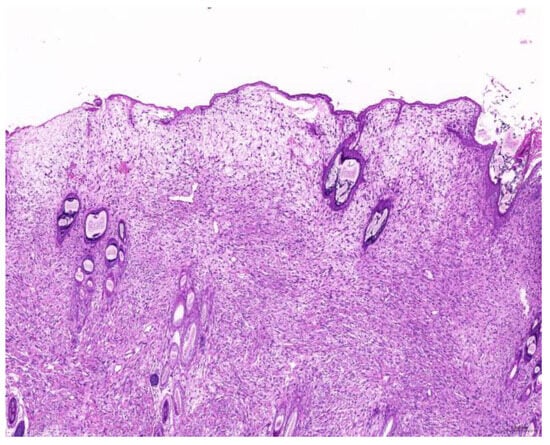
Figure 1
Open AccessArticle
UFBP1 Ameliorates Heat Stress-Induced Apoptosis via Mitochondria-Mediated Pathway in Bovine Mammary Epithelial Cells
by
Yuan Li, Ran Yu, Shujing Tan, Yunlong Jiang, Longwei Sun, Manman Shen, Chuanjian Zhang, Kunlin Chen and Chengmin Li
Animals 2025, 15(9), 1233; https://doi.org/10.3390/ani15091233 (registering DOI) - 27 Apr 2025
Abstract
Heat stress in dairy cows is aggravated by Global warming, which negatively affects their performance and health, especially high yielding cows are more susceptible to high temperature and humidity in summer. Besides increasing body temperature and reducing feed intake, heat stress also compromises
[...] Read more.
Heat stress in dairy cows is aggravated by Global warming, which negatively affects their performance and health, especially high yielding cows are more susceptible to high temperature and humidity in summer. Besides increasing body temperature and reducing feed intake, heat stress also compromises mammary gland function by inducing apoptosis in bovine mammary epithelial cells (BMECs). UFBP1 (Ufm1-binding protein 1) serves as an essential component of ufmylation, is crucial for the preservation of cellular homeostasis. However, little is known about its contribution to heat stress-induced apoptosis in BMECs. Therefore, the present study aimed to elucidate the effect of UFBP1 on heat stress-induced apoptosis through knockdown and overexpression of UFBP1 in BMECs. The results showed that heat stress triggered cell apoptosis (increased apoptosis rate and Bax/Bcl-2 protein expression) and decreased the expression of genes associated with the production of milk fat and protein both in vivo and in vitro studies. Furthermore, UFBP1 silencing aggravated the high-temperature-induced cell damage, and overexpression of UFBP1 attenuated heat stress-induced mitochondrial dysfunction, as evidenced by increased mitochondrial membrane potential (MMP), ATP synthesis and NAD+/NADH ratio, as well as the reduced reactive oxygen species (ROS) generation. Importantly, the mitochondrial apoptosis pathway triggered by heat stress was blocked by UFBP1, as indicated by the reduced apoptosis rate and Bax/Bcl-2 protein expression. In addition, UFBP1 restored the expression of milk fat and protein-related genes in heat-stressed BMECs. In conclusion, these findings indicate that UFBP1 may serve as a promising therapeutic target for ameliorating heat stress in dairy cows, thereby providing novel theoretical insights into the mitigation of adverse thermal stress effects on livestock productivity.
Full article
(This article belongs to the Special Issue Genetic Research for Improving Livestock Heat Stress Resistance)
►▼
Show Figures

Figure 1
Open AccessArticle
New Strategies of Canine Post-Adoption Support: Methods for a Prospective Longitudinal Cohort Study
by
Emma L. Buckland, Kassandra Giragosian, Eleanor J. Jordan, Rosa E. P. Da Costa, Joshua L. Woodward and Rachel A. Casey
Animals 2025, 15(9), 1232; https://doi.org/10.3390/ani15091232 (registering DOI) - 27 Apr 2025
Abstract
In 2018, Dogs Trust (UK) launched the Post Adoption Support project, the largest known prospective cohort study investigating behavioural and health problems post-rehoming of dogs. Individuals adopting a dog from any UK Dogs Trust Rehoming Centre are eligible to receive phone calls regarding
[...] Read more.
In 2018, Dogs Trust (UK) launched the Post Adoption Support project, the largest known prospective cohort study investigating behavioural and health problems post-rehoming of dogs. Individuals adopting a dog from any UK Dogs Trust Rehoming Centre are eligible to receive phone calls regarding their dog’s health and behaviour at specific timepoints after adoption (2 days, 2 weeks, 4 months). Alongside providing an early and proactive framework to support the wellbeing of the adopter and dog, the project collects rich longitudinal data on dog health and behaviour following adoption to assess the development of issues, the impact of support given, and re-relinquishment risk. This paper details the methodology and study design of the Post Adoption Support project and describes a cohort profile of adoptions over an initial 6-month period. In the cohort, behaviour and health data were collected from 5498 adopters, with call success for those eligible ranging from 72% (4 months) to 89% (2 days). Data from these calls will provide significant insights into canine welfare during the first 4 months post-adoption, which can be used to inform strategies for effective and impactful rehoming and post-adoption support.
Full article
(This article belongs to the Special Issue Second Edition: Research on the Human–Companion Animal Relationship)
►▼
Show Figures
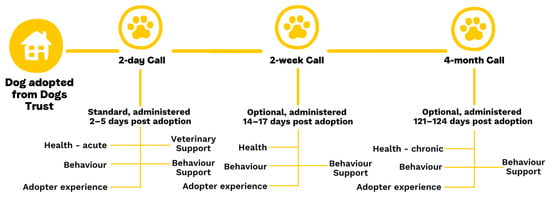
Figure 1
Open AccessArticle
Parabacteroides goldsteinii Alleviates Intestinal Inflammation in Dextran Sulfate Sodium-Treated Pigs
by
Xu Deng, Taozong Guo, Yang He, Shengnan Gao, Jirong Su, Hongbin Pan and Anjian Li
Animals 2025, 15(9), 1231; https://doi.org/10.3390/ani15091231 (registering DOI) - 27 Apr 2025
Abstract
Intestinal inflammation in piglets leads to diarrhea, decreased immune function, and dysbiosis of the gut microbiota. Probiotics are widely recognized and used in the prevention and control of enteritis in piglets. Parabacteroides goldsteinii (PG) is a probiotic, and there are few reports on
[...] Read more.
Intestinal inflammation in piglets leads to diarrhea, decreased immune function, and dysbiosis of the gut microbiota. Probiotics are widely recognized and used in the prevention and control of enteritis in piglets. Parabacteroides goldsteinii (PG) is a probiotic, and there are few reports on the anti-inflammatory properties of this in piglets. Therefore, this study selected 10 Duroc × Landrace × Yorkshire (DLY) piglets aged 50 days and randomly divided them into a control group (CT group) and an experimental group (PG group) for a 14-day experiment. During days 1–7, the PG group established an inflammation model by gavage with 4% dextran sulfate sodium (DSS). The results showed that DSS increased the content of IL-6 and IL-8 (p < 0.05), while it decreased the content of IL-10 in the serum (p < 0.05), For days 8–14, the DSS-treated piglets were administered a 7.9 × 108 CFU/mL PG suspension via gavage. The content of IL-6, IL-8, and IL-10 in the piglets did not differ between the CT and PG groups (p > 0.05). Some beneficial bacteria, such as Lactobacillales and Butyricimonas, were significantly enriched in the PG group (p < 0.05). The PG group showed lower alpha diversity (p < 0.05), and the metabolic pathways exhibited the highest abundance in the KEGG functional prediction analysis. The above studies confirm that PG alleviates intestinal inflammation and changes the gut microbial composition.
Full article
(This article belongs to the Section Pigs)
►▼
Show Figures
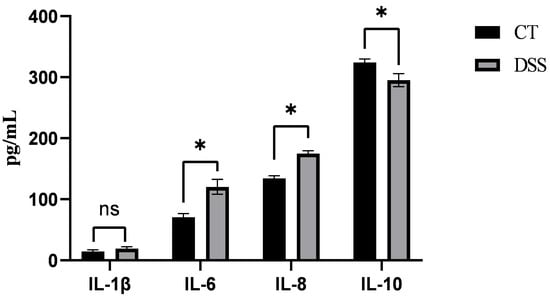
Figure 1
Open AccessFeature PaperArticle
Assessing the Impact of the Methane Inhibitors 3-Nitrooxypropanol (3-NOP) and Canola Oil on the Rumen Anaerobic Fungi
by
Eóin O’Hara, Nora Chomistek, Stephanie A. Terry, Karen A. Beauchemin and Robert J. Gruninger
Animals 2025, 15(9), 1230; https://doi.org/10.3390/ani15091230 (registering DOI) - 27 Apr 2025
Abstract
Reducing enteric methane emissions is critical for improving the sustainability of ruminant livestock production. In this study, we investigated the impact of the methane inhibitors 3-nitrooxypropanol (3-NOP) and canola oil, fed both individually and in combination, on the anaerobic gut fungi (AGF) of
[...] Read more.
Reducing enteric methane emissions is critical for improving the sustainability of ruminant livestock production. In this study, we investigated the impact of the methane inhibitors 3-nitrooxypropanol (3-NOP) and canola oil, fed both individually and in combination, on the anaerobic gut fungi (AGF) of the rumen. Eight ruminally cannulated Angus heifers were used in a replicated double 4 × 4 Latin square over 28-day periods with a 2 (control, 3-NOP) × 2 (control, canola oil) factorial arrangement. Rumen samples were collected after 13 d dietary adaptation, and AGF communities were evaluated using amplicon sequencing of the D1/D2 region of the 28S rRNA (LSU) gene. Although 3-NOP reduced methane yield by approximately 32%, it did not substantially alter the diversity, composition, or overall abundance of the AGF community. In contrast, canola oil supplementation, either alone or combined with 3-NOP, markedly disrupted the fungal community. These treatments reduced overall fungal diversity and the abundance of key fiber-degrading taxa, such as Neocallimastix and Piromyces, while eliciting variable responses among less abundant genera. Furthermore, resilience analyses using control-diet-fed samples indicated that repeated perturbation impaired the recovery of some AGF taxa, leading to a shift in the composition of the fungal community. Overall, our findings suggest that 3-NOP offers a targeted methane mitigation strategy and does not alter the rumen AGF. In contrast, the addition of canola oil at levels that inhibit enteric methane emissions has a disruptive impact on the AGF community, contributing to reduced feed digestibility.
Full article
(This article belongs to the Special Issue Feed Additives in Animal Nutrition)
Open AccessArticle
Dietary Supplementation with Complex Enzymes and Tea Residue Improved the Production Efficiency of Xiangling Pigs
by
Runhua Yang, Yulian Li, Zhenyu Lei, Maisheng Wu, Hong Tan, Fang Liu, Yanmei Gong, Weijian Zhong, Jiayan He, Shujuan Zeng, Zhiyong Fan and Shusong Wu
Animals 2025, 15(9), 1229; https://doi.org/10.3390/ani15091229 (registering DOI) - 27 Apr 2025
Abstract
This study evaluated the effects of tea residue combined with complex enzymes on the growth performance, serum biochemistry, meat quality, and intestinal microbiota of Xiangling fattening pigs. A total of 120 healthy Xiangling fattening pigs, with an average weight of 47.93 kg (±15.28
[...] Read more.
This study evaluated the effects of tea residue combined with complex enzymes on the growth performance, serum biochemistry, meat quality, and intestinal microbiota of Xiangling fattening pigs. A total of 120 healthy Xiangling fattening pigs, with an average weight of 47.93 kg (±15.28 kg), were randomly assigned to five treatment groups, each comprising four replicates of six pigs. The control group (CON) received a basal diet; the experimental groups received a diet containing 5.8% fermented tea residue as an alternative energy and protein source (dry matter basis) and mixed additional 0 (CZ), 200 (M200), 400 (M400), and 800 (M800) complex enzymes. The trial lasted for 83 days. The results showed that tea residue and complex enzymes failed to affect growth performance (p > 0.05). Tea residue reduced the serum aspartate aminotransferase and alkaline phosphatase activities (p < 0.01), and complex enzyme supplementation lowered the total cholesterol levels and reduced the alanine aminotransferase activity (p < 0.05). Additionally, tea residue decreased the pH24h and b*1h values (p < 0.05), and complex enzyme supplementation increased the L*24h value and pork shear force (p < 0.05). In terms of amino acid content, tea residue significantly elevated aspartic acid and inosine monophosphate (p < 0.05), and complex enzyme addition increased the glutamic acid, lysine, alanine, valine, tyrosine, isoleucine, leucine, and phenylalanine levels (p < 0.05). The 800 mg/kg complex enzyme group exhibited a reduction in the C10:0, C15:0, and C17:0 contents (p < 0.05). Microbial analysis showed that tea residue promoted the abundance of Oribacterium and Butyricicoccus, while enzyme supplementation enriched Eggerthellaceae, Oscillospirales, and Peptococcaceae. Overall, the combination of tea residue and complex enzymes improved the pork quality, enhanced metabolic health markers, and modulated the gut microbiota composition, with the 400 mg/kg enzyme dose (M400) achieving the most pronounced benefits. These findings suggest a potential feeding strategy for improving pork quality without compromising growth performance.
Full article
(This article belongs to the Section Pigs)
Open AccessArticle
Understanding the Impact of Social Stress on Serum Metabolome and Saliva Biomarkers in Growing–Finishing Pigs
by
Marc Bagaria, Núria Tous, David Torrallardona, Jose Joaquín Cerón, Estefanía Pérez-Calvo, Wen Ren, Rosa Argamasilla and Emma Fàbrega
Animals 2025, 15(9), 1228; https://doi.org/10.3390/ani15091228 (registering DOI) - 27 Apr 2025
Abstract
High levels of social stress are known to negatively impact pig welfare. The aim of this study was to evaluate the impact of social stress in growing–finishing pigs by measuring serum metabolome changes and saliva biomarkers. Seventy-two undocked pigs (thirty-six males and thirty-six
[...] Read more.
High levels of social stress are known to negatively impact pig welfare. The aim of this study was to evaluate the impact of social stress in growing–finishing pigs by measuring serum metabolome changes and saliva biomarkers. Seventy-two undocked pigs (thirty-six males and thirty-six females) were housed in single-sex pens of four, with the second dominant pig in each pen selected as the focal pig. A social challenge was conducted by mixing the focal pig with three new pigs in its home pen on two consecutive days on trial days 62–64. Saliva and blood samples were collected, and the pigs’ behaviour and body lesions were evaluated pre- and post-challenge. A total of 630 serum metabolites were analysed, 292 of which could be statistically compared using Biocrates WebIDQ v5 software. Salivary haptoglobin concentrations and the number of body lesions significantly increased after the challenge (p < 0.001), whereas the average daily weight gain decreased (p < 0.05). The serum showed decreases in essential amino acids (Thr, Met, and Phe), non-essential amino acids (Glu, Asn, Asp, Pro, and Tyr), betaine, ornithine, indoxyl sulphate, taurine, and some blood di- and triacylglycerols (q < 0.05), and increases in oleic, eicosanoic, eicosadienoic, and dihomo-gamma-linolenic acids; EPA; and DHA post-challenge (q < 0.05). Overall, the results suggest the potential of metabolomics as a tool providing a more holistic view of the impact of social stress.
Full article
(This article belongs to the Special Issue Saliva and Blood Markers in Animal Welfare and Health Monitoring)
►▼
Show Figures
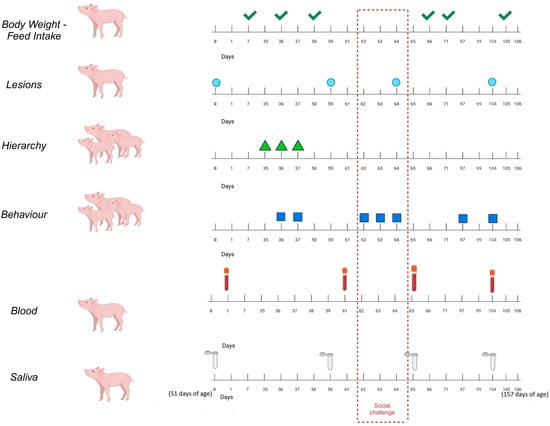
Figure 1
Open AccessArticle
Influence of Halal Slaughter on the Colour, Odour, Flavour, and Textural Properties of Beef
by
Said Bouzraa, Estrella I. Agüera, Carmen Avilés-Ramírez and Salud Serrano
Animals 2025, 15(9), 1227; https://doi.org/10.3390/ani15091227 (registering DOI) - 27 Apr 2025
Abstract
This study aimed to compare different cattle slaughter methods, with and without stunning, and their impact on the sensory attributes and textural properties of beef. A total of 45 meat samples were collected at the slaughterhouse. Fifteen samples were taken from the Transversus
[...] Read more.
This study aimed to compare different cattle slaughter methods, with and without stunning, and their impact on the sensory attributes and textural properties of beef. A total of 45 meat samples were collected at the slaughterhouse. Fifteen samples were taken from the Transversus abdominis muscle (five per slaughter method), and thirty samples were taken from the pectoralis muscle (ten per slaughter method). Sensory and instrumental analyses were conducted to assess odour, flavour, colour, water-holding capacity, and texture. The results indicated that beef from halal slaughter with reversible stunning exhibited lower scores for urine and milk odours, metallic flavour, and red (a*) and yellow (b*) indices, but only in the Transversus abdominis muscle. No significant differences were observed among the methods for other measured parameters. Although religious slaughter without stunning remains legally permitted, it is controversial from an animal welfare perspective. Further research is necessary to develop stunning methods that align with religious requirements while ensuring high meat quality.
Full article
(This article belongs to the Section Cattle)
►▼
Show Figures
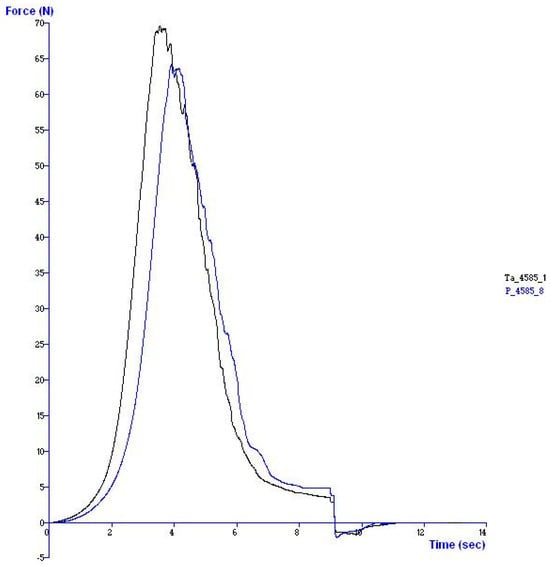
Figure 1
Open AccessSystematic Review
Reproductive Failure in Smallholder Pig Farms in East and Southeast Asia: A Systematic Review
by
Belete Haile, Esa Karalliu, Jeremy Ho, Karyn A. Havas, Renata Ivanek, Joyce Ip, Chen Xin and Omid Nekouei
Animals 2025, 15(9), 1226; https://doi.org/10.3390/ani15091226 (registering DOI) - 26 Apr 2025
Abstract
Reproductive failure has significant socioeconomic impacts on smallholder pig farms. This systematic review was conducted to compile the types of reproductive failures and their underlying causes reported in smallholder pig farms from East and Southeast Asia and to identify relevant knowledge gaps. Following
[...] Read more.
Reproductive failure has significant socioeconomic impacts on smallholder pig farms. This systematic review was conducted to compile the types of reproductive failures and their underlying causes reported in smallholder pig farms from East and Southeast Asia and to identify relevant knowledge gaps. Following the Preferred Reporting Items for Systematic Reviews and Meta-Analyses (PRISMA) guidelines, 26 peer-reviewed studies met the eligibility criteria and were included in our synthesis. These studies were conducted in 11 countries, with Vietnam, China, and Thailand representing the highest share (53.8%). Only six studies (23%) investigated reproductive failure as their primary objective. Stillbirth, mummification, late-term abortion, and weak-born piglets were the predominant reproductive failures reported from smallholder pig farms across the region. The most frequently cited viral pathogens associated with these failures were porcine reproductive and respiratory syndrome virus (PRRSV) and porcine circovirus 2 (PCV-2). Common non-infectious risk factors included extreme climate conditions (e.g., heat stress), poor diet and housing, and suboptimal boar management. Our synthesis highlighted a dearth of research focused on reproductive failure in smallholder pig farms in the region and emphasised the need for more targeted studies to clarify the biological, environmental, and managerial risk factors contributing to reproductive failure. This will facilitate the development of targeted prevention and control measures that account for the unique farming conditions and challenges smallholder farms face in East and Southeast Asia.
Full article
(This article belongs to the Special Issue Infectious Diseases on Livestock Reproduction)
Open AccessFeature PaperArticle
Environmental Gradients and Hen Spatial Distribution in a Cage-Free Aviary System: Internet of Things-Based Real-Time Monitoring for Proactive Management
by
Francesco Bordignon, Mattia Pravato, Angela Trocino, Gerolamo Xiccato, Francesco Marinello and Andrea Pezzuolo
Animals 2025, 15(9), 1225; https://doi.org/10.3390/ani15091225 (registering DOI) - 26 Apr 2025
Abstract
This study assessed environmental gradients at different heights in a multi-tiered aviary and their relationship with hen spatial distribution. Two pens of an experimental aviary housing 225 Novogen hens (Novogen S.A.S., Plédran, France) each were monitored when their hens were 32–52 weeks old
[...] Read more.
This study assessed environmental gradients at different heights in a multi-tiered aviary and their relationship with hen spatial distribution. Two pens of an experimental aviary housing 225 Novogen hens (Novogen S.A.S., Plédran, France) each were monitored when their hens were 32–52 weeks old over three periods (January, March, and June). The environmental conditions (humidity, sound intensity, NH3, CO2, and particulate matter; PM: PM1, PM2.5, PM4, and PM10) were continuously recorded every 10 min, 24 h per day, at three heights (floor and middle and upper tiers) using an IoT-based system. Hen distribution was analysed using video recordings from 04:00 to 20:00, scanning 15 min for every 30 min of video. On the whole, the air quality was always consistent with the recommended values for laying hens. The middle tier, where nests were located, exhibited a higher humidity and CO2 and PM concentration compared to the upper tier and floor, suggesting reduced airflow. This result can be related to the reduced length of the experimental barn containing only one row of equipment, which likely affected air circulation and distribution compared to what happens in commercial barns with several rows and a length over 50 m. Hen distribution varied during the day, with hen presence on the floor being highest in the midday (58% of hens) and correlated with increased particulate matter (r = 0.57–0.60; p < 0.001) and NH3 concentrations (r = 0.33; p < 0.001). Hens occupied the upper tier more in June (34% vs. 24% in January; p < 0.001), correlating with lower humidity and PM levels. Understanding daily and seasonal changes in environmental gradients at different aviary tiers could help optimise ventilation schemes and air quality control and ensure hen welfare, health, and production throughout the laying cycle.
Full article
(This article belongs to the Section Animal System and Management)
►▼
Show Figures

Figure 1
Open AccessArticle
South Korea’s National Animal Welfare Policies in Comparison to Legal Frameworks and Systems in Other Countries
by
Yeonjin Park, Hochul Shin and Dahee Park
Animals 2025, 15(9), 1224; https://doi.org/10.3390/ani15091224 (registering DOI) - 26 Apr 2025
Abstract
It is essential to establish a normative framework that ensures the harmonious coexistence of humans and animals from legal and institutional perspectives. This study classifies and compares animal welfare policies in welfare states, identifying distinct policy types across different countries. Using fuzzy set
[...] Read more.
It is essential to establish a normative framework that ensures the harmonious coexistence of humans and animals from legal and institutional perspectives. This study classifies and compares animal welfare policies in welfare states, identifying distinct policy types across different countries. Using fuzzy set ideal type analysis, this study examines seven OECD countries: Austria, Denmark, Germany, South Korea, Sweden, the United Kingdom (UK), and the United States (USA). These countries are consistent with Esping-Andersen’s three welfare state models and actively implement animal welfare policies. This study addresses the limitations of previous studies that focused primarily on animal-related discourses by examining the characteristics of different policy types that integrate two core components of animal welfare policy: animal welfare law and animal welfare systems. This analysis identified four types of animal welfare policies: (1) economic value type (South Korea and the USA); (2) social value type (the UK); (3) rights extension type (Denmark, Germany, and Sweden); and (4) ecological type (Austria). The results show that welfare state animal welfare policies are generally consistent with the ideological characteristics of the welfare system in question. However, Korea presents notable differences, providing valuable insights into its unique approach to animal welfare policy and informing future policy development.
Full article
(This article belongs to the Section Public Policy, Politics and Law)
►▼
Show Figures

Figure 1
Open AccessCommunication
B-Mode Ultrasonography and Acoustic Radiation Force Impulse Elastography in Evaluation of Urothelial Carcinoma in Dogs
by
Ana Paula Luiz De Oliveira, Bruna Bressianini Lima, Denise Jaques Ramos, Gabriela Castro Lopes Evangelista, Igor Cezar Kniphoff Da Cruz, Ricardo Andrés Ramirez Uscategui, Andrigo Barboza de Nardi and Marcus Antônio Rossi Feliciano
Animals 2025, 15(9), 1223; https://doi.org/10.3390/ani15091223 (registering DOI) - 26 Apr 2025
Abstract
Bladder tumors in dogs represent approximately 2% of all malignant lesions recorded, with urothelial carcinoma being the most common and aggressive form. This study aimed to characterize the elastographic properties of canine urothelial carcinoma using ARFI (Acoustic Radiation Force Impulse) elastography and to
[...] Read more.
Bladder tumors in dogs represent approximately 2% of all malignant lesions recorded, with urothelial carcinoma being the most common and aggressive form. This study aimed to characterize the elastographic properties of canine urothelial carcinoma using ARFI (Acoustic Radiation Force Impulse) elastography and to evaluate its diagnostic capacity. Seven dogs with urothelial carcinoma and nine healthy dogs were evaluated, comparing shear wave velocity (SWV) and bladder wall thickness between the groups. The results showed that SWV was significantly higher in dogs with urothelial carcinoma (median of 2.53 m/s) compared with healthy dogs (median of 1.41 m/s) (p = 0.0045). Bladder wall thickness was also greater in dogs with carcinoma (0.28 ± 0.05 cm) compared to healthy dogs (0.14 ± 0.26 cm) (p = 0.0003). Receiver operating characteristic (ROC) curve analysis revealed a high sensitivity (100%) and specificity (88.9%) for SWV in differentiating healthy and neoplastic tissues. These findings suggest that ARFI elastography is a promising tool for diagnosing urothelial carcinoma in dogs, offering a noninvasive and quantitative approach that can complement traditional diagnostic methods. ARFI elastography may aid in early diagnosis and clinical management, improving the prognosis of patients with bladder neoplasia.
Full article
(This article belongs to the Special Issue New Advances in Canine and Feline Diagnostics—2nd Edition)
►▼
Show Figures

Figure 1
Open AccessReview
Application of Artificial Gastrointestinal Tract Models in Veterinary Medicine
by
Sergei Konstantinovich Shebeko, Heorhii Yurievich Drobot, Andrey Georgievich Koshchaev, Svetoslav Dimitrov Todorov and Alexey Mikhailovich Ermakov
Animals 2025, 15(9), 1222; https://doi.org/10.3390/ani15091222 (registering DOI) - 26 Apr 2025
Abstract
Artificial gastrointestinal tract models have become essential tools in veterinary medicine, providing alternatives to in vivo studies, which are labor-intensive, costly, and under certain circumstances even ethically challenging. These in vitro models facilitate the study of digestion, enable disease and host–pathogen interaction modeling,
[...] Read more.
Artificial gastrointestinal tract models have become essential tools in veterinary medicine, providing alternatives to in vivo studies, which are labor-intensive, costly, and under certain circumstances even ethically challenging. These in vitro models facilitate the study of digestion, enable disease and host–pathogen interaction modeling, and allow for the investigation of nutrient absorption, microbiota, and pharmacokinetics. Considering the One Health concept, the application of gastrointestinal tract systems in investigations for animals can clearly reflect human health, and thus, it is pointing to the relevance of the adaptation of already existing models and the development of new models to meet the needs of veterinary and animal farming practices. This review explores and compares the various types of gastrointestinal tract models, including static and dynamic systems, and their applications across different animal species. Specific technical and methodological considerations are discussed for core animal-developed and -tested artificial systems and their integration with common ‘omics’ techniques. Dynamic models, such as RUSITEC and PolyFermS, more accurately simulate in vivo processes, including peristalsis, enzymatic activity, and microbial fermentation. The studies employing tools for ‘omics’ approaches have been conducted with more understanding analysis and comprehensive discussion and results.
Full article
(This article belongs to the Section Veterinary Clinical Studies)
Open AccessCommunication
Detection of Trypanosoma cruzi DNA in Blood of the Lizard Microlophus atacamensis: Understanding the T. cruzi Cycle in a Coastal Island of the Atacama Desert
by
Josefa Borcosque-Avendaño, Nicol Quiroga, Franco Cianferoni, Gabriel Díaz-Campusano, José Luis Marcos, Carezza Botto-Mahan, Fernando Torres-Pérez, Antonella Bacigalupo and Ricardo Campos-Soto
Animals 2025, 15(9), 1221; https://doi.org/10.3390/ani15091221 (registering DOI) - 26 Apr 2025
Abstract
Trypanosoma cruzi, the protozoan causative of Chagas disease, is primarily transmitted through blood-sucking insects and infects mammalian and some reptilian hosts. In Chile, insects of the Mepraia genus are key vectors of T. cruzi in its wild transmission cycle. High prevalence and
[...] Read more.
Trypanosoma cruzi, the protozoan causative of Chagas disease, is primarily transmitted through blood-sucking insects and infects mammalian and some reptilian hosts. In Chile, insects of the Mepraia genus are key vectors of T. cruzi in its wild transmission cycle. High prevalence and mixed infection of T. cruzi lineages have been reported in a Mepraia population on Santa María Island in the Atacama Desert. However, no small mammals have been reported. The island’s vertebrate community is dominated by the lizard Microlophus atacamensis and marine and scavenger birds. This study aimed to research blood samples of M. atacamensis for the presence of T. cruzi DNA (kDNA and satDNA) using conventional PCR (cPCR) and quantitative real-time PCR (qPCR) and estimate parasitemia. Our findings reveal that 39.4% of 33 individuals were positive with both cPCR and qPCR, while when assessing infection with either technique, it rises up to 81.8%. These findings confirm that M. atacamensis is a host of T. cruzi, suggesting its potential role as a key reservoir in the island’s transmission cycle. This study provides new insights into the life cycle of T. cruzi in the coastal Atacama Desert, highlighting the importance of reptiles in the epidemiology of this parasite.
Full article
(This article belongs to the Special Issue Exploring Wildlife Parasitology: Impacts on Health, Biodiversity, and Ecosystems)
►▼
Show Figures

Figure 1
Open AccessArticle
Heat Acclimation Enhances Brain Resilience to Acute Thermal Stress in Clarias fuscus by Modulating Cell Adhesion, Anti-Apoptotic Pathways, and Intracellular Degradation Mechanisms
by
Yingyi Guan, Cunyu Duan, Xinyu Xie, Zhuoying Luo, Dayan Zhou, Yulei Zhang, Guangli Li, Yu Liao and Changxu Tian
Animals 2025, 15(9), 1220; https://doi.org/10.3390/ani15091220 (registering DOI) - 25 Apr 2025
Abstract
Global climate change presents a significant challenge to aquatic ecosystems, with ectothermic fish being particularly sensitive to temperature fluctuations. The brain plays a crucial role in perceiving, regulating, and adapting to thermal changes, and its response to heat stress is crucial for survival.
[...] Read more.
Global climate change presents a significant challenge to aquatic ecosystems, with ectothermic fish being particularly sensitive to temperature fluctuations. The brain plays a crucial role in perceiving, regulating, and adapting to thermal changes, and its response to heat stress is crucial for survival. However, the molecular mechanisms underlying heat stress and acclimation in fish brains remain poorly understood. This study aimed to investigate the adaptive mechanisms of Hong Kong catfish (Clarias fuscus) brains under heat acclimation and acute heat stress using transcriptome analysis. Fish were divided into two groups: a normal temperature group (NT, 26 °C for 90 days) and a heat-acclimated group (HT, 34 °C for 90 days), followed by acute heat stress (34 °C for 72 h) and recovery (26 °C for 72 h). Heat acclimation improved C. fuscus tolerance to acute heat stress, with faster gene responses and stronger neuroprotection. Key pathways enriched included cell adhesion and ECM-receptor interactions during recovery. Apoptosis regulation was balanced, with the HT group upregulating anti-apoptotic genes to mitigate neuronal cell death. Additionally, the lysosome–phagosome pathway was activated during recovery, facilitating the transport of lysosomal enzymes and the clearance of damaged cellular components, aiding neuronal repair. Ribosome biogenesis was suppressed under heat stress to conserve energy, but this suppression was less pronounced in the HT group. In summary, heat acclimation enhances neural protection in C. fuscus brains by promoting neuronal repair, suppressing apoptosis, and activating lysosomal pathways, thereby improving tolerance to acute heat stress. These findings offer a molecular basis for breeding heat-tolerant fish species in aquaculture, and deepen our understanding of thermal adaptation in aquatic animals amid global climate change.
Full article
(This article belongs to the Section Animal Welfare)
►▼
Show Figures

Figure 1
Open AccessArticle
The Platelet Activation Signaling Pathway Regulated by Fibrinogen and Homo-Gamma-Linolenic Acid (C20:3)-Associated Lipid Metabolism Is Involved in the Maintenance of Early Pregnancy in Chinese Native Yellow Cattle
by
Miao Yu, Changzheng Du, Yabo Ma, Yuqin Ma, Pengfei Li, Xianguo Xie, Mengyuan Li, Xueyi Nie, Yueyang Liu, Yuxin Hou, Shenao Miao, Xingping Wang, Jinrui Xu and Yi Yang
Animals 2025, 15(9), 1219; https://doi.org/10.3390/ani15091219 - 25 Apr 2025
Abstract
Identifying the specific factors secreted during early pregnancy is an effective method for pregnancy detection in cattle, helping to reduce empty pregnancies in the industry. To systematically investigate metabolic variations between early pregnancy and the estrous cycle and their relationship with pregnancy progression,
[...] Read more.
Identifying the specific factors secreted during early pregnancy is an effective method for pregnancy detection in cattle, helping to reduce empty pregnancies in the industry. To systematically investigate metabolic variations between early pregnancy and the estrous cycle and their relationship with pregnancy progression, this study utilized four-dimensional data-independent acquisition (4D-DIA) proteomics and liquid chromatography–tandem mass spectrometry (LC-MS/MS) metabolomics to analyze serum samples collected from Chinese native yellow cattle at day 0 and day 21 post-mating, combining bioinformatics analysis with experimental validation. The platelet activation signaling pathway and angiogenesis-related proteins were significantly upregulated. Among them, fibrinogen alpha/beta/gamma chains (FG) exhibited notable differences, with their branched-chain protein FGB showing highly significant upregulation (p = 0.003, Log2FC = 2.167) and tending to increase gradually during early pregnancy, suggesting that FGB could be one of the important indicators of early pregnancy in Chinese native yellow cattle. Among the differential metabolites, 11-Deoxy prostaglandin F1α (p < 0.001, Log2FC = 1.563), Thromboxane B1 (p = 0.002, Log2FC = 3.335), and Homo-Gamma-Linolenic Acid (C20:3) (p = 0.018, Log2FC = 1.781) were also increased, indicating their involvement in the regulation of the platelet activation signaling pathway. The platelet activation signaling pathway plays a crucial role in maternal immune tolerance and placental vascularization, which are essential for embryo implantation and placental development. These findings indicate that FGB has the potential to be a valuable biomarker for early cattle pregnancy detection, thereby improving pregnancy diagnosis accuracy, reducing economic losses caused by undetected empty pregnancies and enhancing reproductive efficiency in the cattle industry. Undoubtedly, our research outcomes must be validated with future studies, and a larger sample size as well as the evaluation of the potential endocrine effects induced by the synchronized estrus treatment must be considered.
Full article
(This article belongs to the Section Cattle)
Open AccessArticle
Ethogram Characteristics of Silver Carp (Hypophthalmichthys molitrix) During the Breeding Period Based on the PAE Coding System
by
Min Wang, Fengyue Zhu, Lixiong Yu, Qingrui Yang, Ke Wang, Mingdian Liu, Xinbin Duan and Daqing Chen
Animals 2025, 15(9), 1218; https://doi.org/10.3390/ani15091218 - 25 Apr 2025
Abstract
Animal behavior diversity is a key element of biodiversity, and the establishment of an ethogram provides a crucial framework for exploring the relationship between behavioral patterns and environmental factors. However, the development of ethograms and the quantitative analysis of behavioral diversity in fish
[...] Read more.
Animal behavior diversity is a key element of biodiversity, and the establishment of an ethogram provides a crucial framework for exploring the relationship between behavioral patterns and environmental factors. However, the development of ethograms and the quantitative analysis of behavioral diversity in fish remain underexplored. In this study, focal animal sampling and instantaneous scan sampling methods, paired with the PAE (Posture-Act-Environment) coding system, were employed to investigate the ethogram and reproductive behavior diversity of silver carp. The findings revealed 12 postures, 20 actions, and 34 behaviors documented during the breeding period of silver carp. Analysis of reproductive behavior diversity revealed that the absolute behavioral diversity index (H), relative behavioral diversity index (r), and regulated diversity index (r-variable) all peaked during the 10–15 h interval following induced spawning. Notably, significant differences (p < 0.001) were observed in these indices across different post-induction time intervals and between sexes. Throughout the breeding cycle, females demonstrated lower diversity and intensity in reproductive behaviors compared to males, suggesting distinct reproductive strategies between the sexes. The reproductive behavior of silver carp exhibited distinct chronobiological disorganization patterns. This study provides a scientific basis for future research on the behavioral ecology of silver carp and the conservation of their wild populations.
Full article
(This article belongs to the Collection Behavioral Ecology of Aquatic Animals)
►▼
Show Figures
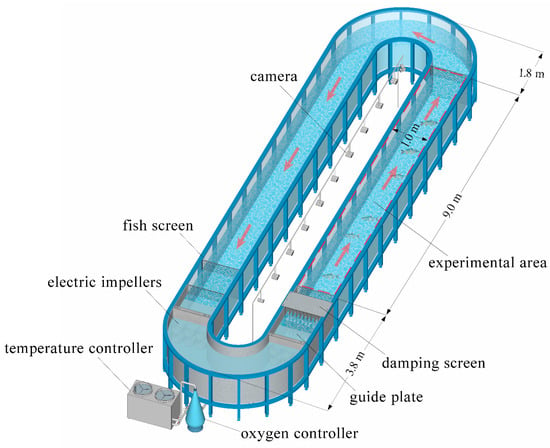
Figure 1
Open AccessArticle
Cloning and Transcriptional Activity Analysis of the Bovine CDH11 Gene Promoter: Transcription Factors Sp1 and GR Regulate Bovine CDH11 Expression
by
Zhanxin Liu, Yanbin Bai, Zongchang Chen, Yanmei Niu, Xue Jia, Liang Li, Xiaolan Zhang, Binggang Shi, Zhidong Zhao, Jiang Hu, Yuzhu Luo, Jiqing Wang, Xiu Liu, Shaobin Li and Fangfang Zhao
Animals 2025, 15(9), 1217; https://doi.org/10.3390/ani15091217 - 25 Apr 2025
Abstract
Growth rate of bovine skeletal muscle has a major impact on beef yield. Cadherin-11 (CDH11) was found to be a potential candidate gene for growth and development in beef cattle. This study confirmed the high expression of CDH11 in bovine longissimus
[...] Read more.
Growth rate of bovine skeletal muscle has a major impact on beef yield. Cadherin-11 (CDH11) was found to be a potential candidate gene for growth and development in beef cattle. This study confirmed the high expression of CDH11 in bovine longissimus dorsi using a tissue expression analysis. To understand the transcriptional regulation mechanism of CDH11 gene, we constructed a double luciferase vector for the promoter region of CDH11 gene and determined that the core transcriptional regulatory region was located at −129/+55 bp relative to the transcription start site (TSS). In addition, we confirmed that skeletal muscle growth and development-related transcription factor-specific protein 1 (SP1) and glucocorticoid receptor (GR) bind to the CDH11 gene promoter region at −36/−27 bp and −20/−11 bp, respectively, to regulate CDH11 expression. These interactions provide valuable information for understanding the mechanism of transcriptional regulation of the bovine CDH11 gene during muscle growth and development.
Full article
(This article belongs to the Section Animal Genetics and Genomics)
►▼
Show Figures

Figure 1

Journal Menu
► ▼ Journal Menu-
- Animals Home
- Aims & Scope
- Editorial Board
- Reviewer Board
- Topical Advisory Panel
- Instructions for Authors
- Special Issues
- Topics
- Sections & Collections
- Article Processing Charge
- Indexing & Archiving
- Editor’s Choice Articles
- Most Cited & Viewed
- Journal Statistics
- Journal History
- Journal Awards
- Society Collaborations
- Conferences
- Editorial Office
Journal Browser
► ▼ Journal BrowserHighly Accessed Articles
Latest Books
E-Mail Alert
News
Topics
Topic in
Agriculture, Animals, Fermentation, Microplastics, Veterinary Sciences
Livestock and Microplastics
Topic Editors: Sonia Tassone, Beniamino T. Cenci-GogaDeadline: 20 May 2025
Topic in
Animals, Antioxidants, Veterinary Sciences, Agriculture
Feeding Livestock for Health Improvement
Topic Editors: Hui Yan, Xiao XuDeadline: 30 May 2025
Topic in
Animals, Dairy, Microorganisms, Veterinary Sciences, Metabolites, Life, Parasitologia
The Complexity of Parasites in Animals: Impacts, Innovation, and Interventions
Topic Editors: Kun Li, Rongjun Wang, Ningbo Xia, Md. F. KulyarDeadline: 31 August 2025
Topic in
Animals, Fishes, Veterinary Sciences
Application of the 3Rs to Promote the Welfare of Animals Used in Scientific Research and Testing
Topic Editors: Johnny Roughan, Laura CalvilloDeadline: 20 September 2025

Conferences
Special Issues
Special Issue in
Animals
Sperm Quality Assessment in Domestic Animals
Guest Editors: Krzysztof Górski, Stanisław KondrackiDeadline: 30 April 2025
Special Issue in
Animals
Advances in Internal Medicine in Equids
Guest Editors: Alejandro Pérez-Écija, Francisco Mendoza GarcíaDeadline: 30 April 2025
Special Issue in
Animals
Nutrition, Gut Microbiome and Health in Dogs and Cats
Guest Editors: Ananda Portella Félix, Ching-Yen Lin, Júlia Guazzelli Pezzali, Rachel Pilla, Jirayu TanprasertsukDeadline: 30 April 2025
Special Issue in
Animals
Canine and Feline Endocrinology: Research Progress and Challenges
Guest Editors: Rodolfo Oliveira Leal, Francesca Del BaldoDeadline: 30 April 2025
Topical Collections
Topical Collection in
Animals
High-Yielding Dairy Cows
Collection Editor: João Carlos Caetano Simões
Topical Collection in
Animals
Behavioral Ecology of Aquatic Animals
Collection Editors: Fang Wang, Shijian Fu
Topical Collection in
Animals
Poultry Feeding and Gut Health
Collection Editors: Paweł Konieczka, Dorota Bederska-Łojewska









